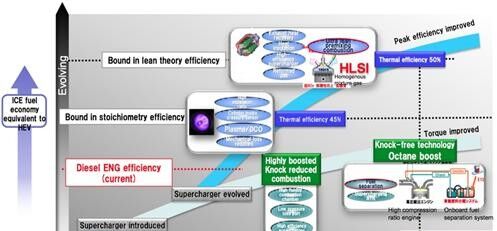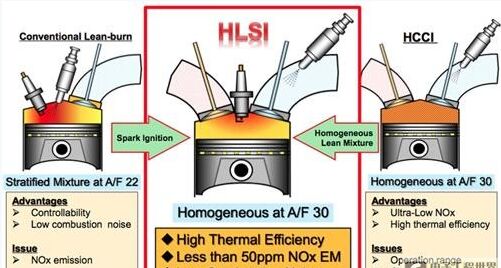Recently, Honda announced the launch of a Homogeneous Lean Charge Spark Ignition (HLSI) engine with high combustion efficiency and low exhaust emissions. As early as 2013, Honda Motor Co. introduced a basic introduction to the technology at the Society of Automotive Engineers (SAE). At the recent 2014 International Society of Automotive Engineers High-Efficiency Internal Combustion Engine Symposium, Takashi Kondo from the R&D department of Honda Motor Co. introduced the test results of the technology to the participants.
This article refers to the address: http://

Toshihiro Mibe, Managing Director of R&D Center of Toyota R&D, presented Honda's engine technology roadmap at the 2013 Asia-Pacific Symposium and the key role of the homogeneous lean-burning engine.
According to Takashi Kondo, the homogeneous lean-burn engine uses an air-fuel ratio stratification technique in which a larger concentration of air-fuel mixture is distributed around the spark plug to aid ignition. In general, the air-fuel ratio of the engine can be compared to the overall stratification technology to achieve the combustion stability of the lean combustion technology engine. Lean burn technology engines have higher combustion efficiencies and greater air to fuel ratios, while reducing engine output losses by increasing air to fuel ratios. However, during the first half of combustion of the engine cylinder, the air fuel is relatively small and the fuel concentration is high. At this time, the engine NOx emission is still relatively large, and the effect of reducing emissions through the three-way catalyst is not very obvious.
Honda Motor Co. hopes to achieve stable and controllable combustion and low NOx emissions by combining lean combustion technology with homogeneous premixing technology. The lean combustion technology has the characteristics of strong combustion controllability and low combustion noise. The homogeneous premixing technology has the characteristics of less nitrogen oxide emissions and high combustion efficiency. This time, Honda's homogeneous lean-burning engine makes full use of the advantages of the above two technologies, and avoids the high emission of nitrogen oxides from lean combustion technology and the low controllability of homogeneous premixing technology. Shortcomings such as high combustion noise and narrow working range.

Honda Motor Co. conceives that the homogeneous lean combustion technology engine can achieve nitrogen oxide emissions of less than 50ppm and has high fuel efficiency and low combustion noise.
Hanabusa et al. said: “There has been a lot of research on effective methods to improve the combustion efficiency of gasoline engines by using lean combustion technology. The purification of nitrogen oxides in exhaust gas by three-way catalysts in engines with lean combustion technology. Not obvious. Therefore, in order to reduce the content of nitrogen oxides in the engine exhaust gas, the limit air fuel ratio can be increased.
In a conventional stratified homogeneous lean burn engine, the concentration of the air-fuel mixture around the spark plug is high, so that a corresponding harmful oxide of nitrogen oxides is generated during the first half of the combustion process. In a typical engine, nitrogen oxides in the exhaust gas are almost 100% purified by the three-way catalyst; however, in a lean-burn engine, the three-way catalyst has almost no purification effect on nitrogen oxides. Therefore, to achieve the emission control standard nitrogen oxides in the tail gas must be purified by a lean NOx catalyst (LNC). When the nitrogen oxide content of the lean nitrogen oxide catalyst exceeds the emission standard, lean combustion in the engine will stop and the high concentration air fuel mixture will begin to burn to reduce the nitrogen oxide content. However, combustion of a high concentration of air-fuel mixture in the engine results in reduced engine fuel efficiency. As emissions standards become more stringent, the proportion of engines that use high-concentration air-fuel mixtures is increasing. At present, the lean burn engine on the market has basically stopped selling.
In order to solve the above problems, automotive technicians have conducted extensive research on Homogeneous Charge Compression Ignition (HCCI). However, due to the short-working range and low controllability of the combustion, the homogeneous charge compression ignition engine failed to enter mass production.
In order to improve the fuel efficiency of the engine and to save costs, Honda Motor Company's research mainly uses lean combustion technology without using a thin nitrogen oxide catalyst. The technology discussed in this paper primarily uses lean burn technology and uses a stable spark plug to ignite a homogeneous combustible mixture to achieve low NOx emissions and high combustion controllability. All in all, the main purpose of this research by Honda Motor Co., Ltd. is to understand the principle mechanism that homogeneous lean combustion technology can reduce nitrogen oxide emissions, and this goal has been successfully achieved. Based on the principle mechanism obtained from this research, Honda Motor Co.'s research aims to develop a lean-burning engine with high fuel efficiency and low nitrogen oxide emissions. â€
It is well known that homogeneous thin air fuel premixed gases have poor flame propagation properties. In order to determine the main cause of this phenomenon, Honda Motor Co. conducted an experimental study in which a single-cylinder engine was used to experimentally study the combustion characteristics of the engine by changing the combustion compression ratio and intake air temperature of the single-cylinder engine.
In the first few experiments, Honda Motor Co. modified the single-cylinder engine with fuel injected into the engine from an upstream port syringe located about 1 meter above the engine. During this injection process, the fuel can be thoroughly mixed with the air to obtain a well-mixed air-fuel mixture which is then heated by the heater and finally delivered to the engine. Honda Motor Co., Ltd. has experimentally studied the factors affecting the lean burn limit by changing the combustion compression ratio and intake air temperature of the engine.
The researchers found that the period of abnormal combustion is mainly caused by combustion fluctuations, and the combustion temperature at the top dead center of the abnormal combustion cycle is generally lower than other stable combustion cycles. The temperature of the unburned gas at the top dead center during the abnormal combustion cycle is lower than 950 degrees Kelvin (about 677 degrees Celsius), so it has a very undesirable thermal effect in the engine expansion stroke.
The researchers also found that when the temperature of the unburned air fuel mixture exceeds 1000 degrees Kelvin (about 727 degrees Celsius), the laminar combustion rate in the engine will increase rapidly. Among them, when the temperature of the unburned air fuel mixture reaches or exceeds 1000 Kelvin, the hydrogen peroxide will decompose to generate OH radicals, thus greatly increasing the burning rate.
In order to convert the experimental combustion concept into a product as quickly as possible, Honda Motor Co., Ltd. experimented with a single cylinder of a four-cylinder engine, where the top dead center combustion temperature could exceed 1000 degrees Kelvin. Although Honda Motor Co. retained the engine's own intake injection system, the researchers improved the installation of the atomizing nozzle so that the air fuel mixture could be more fully mixed.
Before the engine reaches the top dead center, its laminar burning speed is slow. In order to improve the thermal effect of the lean air fuel mixture at this time, the experimenters used different compression ratios, different intake systems, different piston shapes and different ignitions. The system is used for experimental research.
Through the above improvements, the air fuel ratio limit of the test engine was raised to A/F 31. When the engine's air-fuel ratio is A/F 30, the engine has the highest fuel efficiency and its nitrogen oxide emissions are also less than 50ppm. At this time, the engine speed was 1,500 rpm, and the net Mean Effective Pressure (NMEP) in the engine cylinder was 500 kPa.
Featuring level VI energy efficiency and meet IEC/EN/UL 62368 safety standards for ITE/AV equipment, the external universal power adapter accepts the output power rating of 75W with universal AC input voltage range from 100-240VAC and provides 3 Years warranty. These series power adapters use PC flame retardant material housing, all materials conform to the international environment protection standard. Protections for over voltage, over current and short circuit are also included.
EN61558 Ac adapter,Laptop Adapter,16V Ac Power Adapter,Universal AC Adapter,ac adapter 16v 1.5a,ac 16v 3a adapter
Shenzhenshi Zhenhuan Electronic Co Ltd , https://www.szzhpower.com